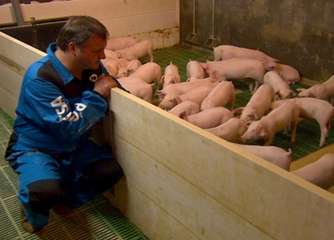Pig farmers get smart

Low-cost sensors and wireless communication technologies have enabled moves towards smart homes and smart cars. Using similar technologies, scientists involved in an EU-funded project called ALL-SMART-PIGS are now developing technologies that turn pigs' farms into smart farms. "ALL-SMART-PIGS aims to come up with a package of technologies to make pig farming more profitable while at the same time improving animal welfare," explains the project coordinator Heiner Lehr, who is a partner with the Barcelona office of Syntesa, in Spain, an international innovation consultancy. "We are using sensors to detect animals' needs," Lehr tells CommNet, adding: "and by satisfying those needs more quickly, the payback is healthier animals that grow faster, so it's win-win for the animals and the farmer."
The technologies have now been installed on working farms in Spain and Hungary. In the latter case, sound monitoring for coughing has, once, already provided an early indication of respiratory illnesses. Likewise, tracking feed consumption and animal weight gain could provide an early warning of health problems. The equipment is designed to generate valuable insight into so-called feed efficiency conversion – a key metric for both farmers and feed companies to evaluate how efficiently animals convert feed to weight gain. Meanwhile, air quality monitoring is aimed at helping farmers to optimise animal welfare.
So is smart farming— or precision livestock farming (PLF) as the industry prefers to call it—the way of the future? "The big challenge will be in handling a lot of raw data from different devices," points out Sjaak Wolfert, a senior scientist in agrifood information management and ICT at LEI, the Agricultural Economics Research Institute, in The Hague, the Netherlands. "Many manufacturers are not willing to cooperate with perceived competitors," Wolfert comments, adding: "although there has been talk about the need for standardisation for many years, developments are now coming from so many directions that it's difficult to keep pace."
There are also questions, Wolfert believes, over governance in relation to who owns the data and whether farmers may be reluctant to send herd information to the cloud. "There needs to be open innovation throughout the business ecosystem: users, developers, everyone needs to be getting added value," he explains.
Such projects require a high level of coordination. "The big challenge has been getting everything to work together and bringing the entire supply chain from the feed suppliers to the slaughterhouses on board," Lehr notes. The project now provides a model to achieve effective collaboration. However, it encountered the practical obstacle of poor broadband quality; not uncommon in rural parts of Europe. "We had to install pretty advanced technology on one of the Spanish farms to allow us to upload the image and sound files," Lehr tells CommNet.
This poses a second question. What sort of investment will be required to add smart technology to the average European pig farm? And will it be justified by the likely return? Lehr says that sophisticated PLF technologies are already being specified in a number of new, large-scale pig production units at the design stage in various locations around Europe. However, with smaller farms and retrofitting existing units, his instincts are that for the moment, at least, the economic case may have to be supported by the 'social argument'. "Farmer motivation can be a complex matter," Lehr explains. "Milking robots on dairy farms don't save money, but some farmers still use them so they don't have to get up at 4am in the morning to milk the cows and they can go away on vacation."
Consumer pressure for improved animal welfare is another driver. "In Germany, the UK, and the Netherlands, we are seeing major retailers supporting precision livestock farming as part of a move to quantify animal welfare," Lehr notes. Other experts believe that some investment in smart technology can be justified on economic grounds alone. "Producers who are really concentrating on improving animal health through approaches like PLF have been getting phenomenal results in terms of increasing feed conversion efficiency, litter size and so on, so much so that some are embarking on modest expansion," comments Mike Varely, director of The Pig Technology Company in Leeds, UK, "It is now seen as a major driver for improving productivity in the industry."
He agrees that large-scale producers can expect the greatest payback but insists that "even smaller production units will get a return from investing in some smart technologies – if they choose wisely." As to the adoption of the all-embracing PLF management technologies of the type envisaged by project, Varley says: "It's definitely where things are headed, but we have still some way to go."
Provided by Youris.com

















